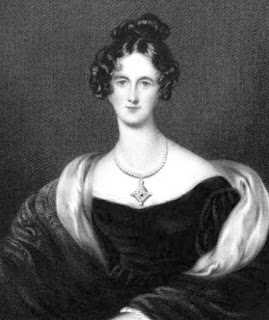I was recently contacted by Jayne Parkes who had inherited a wonderful historical booklet from her mother and wanted to know whether I could tell her anything about it. Jayne has very kindly agreed to let me share her booklet with you.
A souvenir booklet
The booklet is labelled ‘Souvenir’ and contains a miniature of a lady and a lock of hair.
This would be interesting enough in itself, but in addition, the booklet includes the following note:
As far as I have been able to make out, the text reads:
The booklet is labelled ‘Souvenir’ and contains a miniature of a lady and a lock of hair.
 |
| Miniature of Lady Jersey in souvenir booklet © Jayne Parkes |
 |
| Lock of hair of Lady Jersey in souvenir booklet © Jayne Parkes |
As far as I have been able to make out, the text reads:
“Pocket book with miniature & lock of hair of Sarah (nee Fane) Countess of Jersey given by her to my mother Louisa Mrs Hope (afterwards Viscountess Beresford)Signed A J B Beresford Hope May 6 1883Nb the almanack (?) lines/here (?) date 1817Lady Sarah Sophia Fane daughter of John 10th Earl of Westmorland born March 4, 1785, married May 23 1804 George 5th Earl of Jersey, died Jan 26 1867”
Lady Jersey
Let us first consider the subject of the miniature. Sarah Child Villiers, Countess of Jersey (1785-1867), was one of the leading figures of Regency society. You can read more about her in a previous post on this blog. I am not sure what the line ending ‘date 1817’ says, but the details below it concern the birth, marriage and death of Lady Jersey and this information tallies with other sources.
But is the miniature really of Lady Jersey? Below is a close up of the miniature compared with a portrait of Lady Jersey that appeared in The Illustrated Belle Assemblée for 1844 on the left and a print of her on display at Osterley Park on the right. I think that the similarity is very good.
 |
| Left: Lady Jersey from The Illustrated Belle Assemblée (1844) Centre: Miniature shown above © Jayne Parkes Right: Lady Jersey from a print on display at Osterley Park |
Viscountess Beresford
The miniature was given to Louisa, Viscountess Beresford. In 1837, The Court Magazine and Monthly Critic printed a portrait of the Viscountess together with a brief history of who she was and, very usefully, a list of her children by her first marriage.
Louisa Beresford was the youngest daughter of William Beresford, 1st Lord Decies and Archbishop of Tuam, and his wife Elizabeth Fitzgibbon. William Beresford was the brother of George de la Poer Beresford, 1st Marquess of Waterford.
Louisa married Thomas Hope of Deepdene, Surrey, on 16 April 1806. Thomas Hope was a merchant banker, art collector and author. His most famous publication was Anastasius (1819) — a racy novel which rivalled the popularity of Byron’s work and was said to have made Byron weep because he had not written it!
 |
| Deepdene, Surrey, the seat of Thomas Hope, from Select Illustrations of the County of Surrey by GF Prosser (1828) |
Louisa and Thomas had three sons: Henry Thomas Hope; Adrian John Hope and Alexander James Beresford Hope. Thomas Hope died on 2 February 1831 leaving his wealth and art collections to his eldest son Henry.
William Carr Beresford
 |
| Viscount Beresford engraved by P Lightfoot from picture by G Bradley inLife of Field-Marshal His Grace the Duke of Wellington by WH Maxwell (1840) |
William and Louisa had no children and on his death in 1854, William's estates passed to Louisa’s youngest son, Alexander, who took the additional name Beresford from this time. It is Alexander’s signature—AJB Beresford Hope—that is on the note shown above.
The painter
 |
| Close-up of signature on miniature of Lady Jersey in souvenir booklet © Jayne Parkes |
I have not been able to find out anything else about this painter, but there is another portrait by him from the Metropolitan Museum of Art website shown below. As you can see, the signature is virtually identical.
 |
| Portrait of a Woman, said to be Madame Récamier (1777-1849) by Nicolas François Dun c1812-14 |
Note
1. Sometimes Dun’s name is spelt Nicolas without the ‘h’.
Sources used include:
Courthope, William, editor, Debrett's Complete Peerage of the United Kingdom of Great Britain and Ireland (1838)
Court Magazine and Monthly Critic (1837)
Anastasius — The Novel Which Made Byron Weep! on The Regency Redingote



Good sleuthing!
ReplyDeleteThank you. :) I do love a bit of a mystery to solve.
DeleteIn enlarging the image, I believe the line in questions states " the almanack leaves here date 1817". Pages were often called "leaves." Is the book an almanac? An almanac could be a general interest book about a pastime as well as the book of maps we think of today. What a lovely gift.
ReplyDeleteThanks for our comment. I am not sure what else is in the booklet. I will have to go back to the owner and ask.
Delete